Top Fungicides for Optimal Soybean Farming


Topic Overview
Definition and Importance
Fungicides are chemical agents used to combat fungal diseases that threaten crops. In soybean cultivation, these agents play a pivotal role in protecting the plants from pathogens such as Phytophthora sojae, which can lead to significant yield losses. The importance of fungicides cannot be overstated as they help ensure healthy growth and development of the soybean plants, ultimately supporting farmer income and food production stability.
The selection of the right fungicide can make or break a season for soybean farmers. Using these products effectively not only safeguards yields but also helps in maintaining sustainable farming practices.
Brief History and Evolution
Historically, the application of fungicides dates back several decades, with early formulations primarily derived from natural sources. As the agricultural sector evolved, so did the complexity of fungicides. The 20th century witnessed remarkable advancements from broad-spectrum fungicides to more specialized formulations targeting specific diseases. This evolution reflects ongoing research into fungal resistance and the pressing need for efficient crop management tools, driven by increased crop demands and changing climate.
Notably, innovations such as systemic fungicides have transformed application practices and improved efficacy. Farmers now have access to a range of products tailored to the nuances of soybean farming, making informed decision-making more crucial for crop health.
Key Techniques and Innovations
Sustainable Farming Practices
Sustainable agriculture emphasizes environmental stewardship alongside production efficiency. Integrated Pest Management (IPM) is one technique that incorporates fungicide use in a holistic farming strategy. This practice encourages using various control methods, such as crop rotation and resistant soybean varieties, to minimize reliance on chemical inputs.
An example of sustainable practice includes foliar spraying with targeted fungicides at critical growth stages, which not only preserves yield but also mitigates negative environmental impacts.
Advanced Agronomic Technologies
Technological advancements have introduced precision agriculture tools that optimize fungicide application. Drones, equipped with imaging technology, allow farmers to monitor plant health and identify diseases early on. Meanwhile, software applications provide insights into weather patterns and disease forecasts, enabling precise fungicide application timing.
"Precision is the new normal in soybean farming, where the right application at the right time can lead to optimal results."
These technologies enhance farmers' capacity to respond proactively, improving not only crop outcomes but also their overall management approach.
Practical Applications
Step-by-Step Guides
The process of selecting and applying fungicides involves several key steps:
- Identification of Diseases: Understanding the specific diseases affecting the soybean crop is crucial.
- Selecting the Right Fungicide: Farmers must choose based on active ingredients and modes of action suitable for their specific needs.
- Application Timing: Timing is everything; applying at the right development stage of the plant can increase effectiveness.
- Monitoring and Evaluation: Post-application assessments help in gauging the effectiveness of the fungicide used.
Case Studies or Real-World Examples
A study in the Midwestern United States showed that farmers who implemented a program of regular pathogen monitoring and strategically applied fungicides saw a yield increase of over 20%. This case highlights the direct connection between proper fungicide application and crop productivity. In another instance, farmers adopting IPM practices reported lower chemical use, translating to higher profits and reduced environmental impacts.
By sharing these experiences, the importance of adapting fungicide strategies becomes clear, reinforcing the value of tailored approaches in modern soybean farming, ultimately leading to better sustainability and productivity.
For more in-depth information on fungicides and agricultural best practices, consider visiting National Agricultural Statistics Service and American Soybean Association.
Prologue to Soybean Cultivation
Soybean cultivation holds significant importance within the sphere of modern agriculture. They are not just any crop; they have a knack for playing a pivotal role in ensuring food security, economic stability, and sustainability. Think about it: soybeans are among the most versatile crops, serving as feed for livestock, a key ingredient in numerous food products, and even as a source for biofuels and industrial products. As you dive into the realm of soybeans, understanding their cultivation becomes essential. It guides farmers to make informed choices, especially in an age where agricultural practices must adapt to challenges like climate change and pest resistance.
Importance of Soybeans in Agriculture
The relevance of soybeans in agriculture is akin to a linchpin in a machine; without it, everything could fall apart. These legumes are not only rich in proteins but also pivotal in crop rotation schemes, enhancing soil quality by fixing nitrogen. This means healthier soils and, in turn, better yields for future crops. Additionally, given the increasing global demand for plant-based proteins, soybeans stand at the forefront, satisfying the appetites of millions.
- Economic Value: With billions generated in exports, soybeans bolster local economies and provide employment.
- Ecosystem Services: Their cultivation promotes biodiversity, making soybean fields a haven for various wildlife species.
- Versatility: From tofu to soybean oil, they cater to diverse market needs.
In short, soybeans are not merely a crop; they're an agricultural powerhouse.
Challenges Faced in Soybean Farming
Despite their advantages, soybean farming is not all sunshine and rainbows. Farmers face a myriad of challenges that could make cultivating this crop a tricky business. Picture a jigsaw puzzle where some pieces are missing—that's how it feels trying to predict and manage these difficulties.
- Fungal Diseases: Various diseases, from Powdery Mildew to Phytophthora Root Rot, can devastate crops if not managed properly. These threats necessitate the need for effective fungicides.
- Market Fluctuations: Prices of soybeans can be volatile, influenced by global demand, trade policies, and competition from other crops.
- Weed and Pest Resistance: Just like anything else, over-reliance on certain farming methods can lead to resistance in pests and weeds, complicating the farming process.
"Successful soybean cultivation is a balancing act; farmers must weigh the rewards against the risks and uncertainties that abound."
In essence, a comprehensive understanding of these hurdles is paramount for anyone serious about soybean farming. It’s not just about planting seeds and hoping for rain; it’s about creating a robust strategy that secures both yield and sustainability.
Understanding Soybean Diseases
Grasping the intricacies of soybean diseases is of paramount importance for anyone involved in soybean cultivation. Knowledge about these diseases not only assists farmers in managing their crops effectively but also helps in improving yields and overall resilience against expected and unforeseen challenges. Fungal diseases can lead to significant losses if not recognized and addressed in a timely manner. Furthermore, being able to diagnose these issues at early stages empowers farmers to make informed decisions regarding their crop management practices. This section will delve into the common fungal diseases affecting soybeans, highlighting their implications as well as the symptoms to look out for.
Common Fungal Diseases Affecting Soybeans
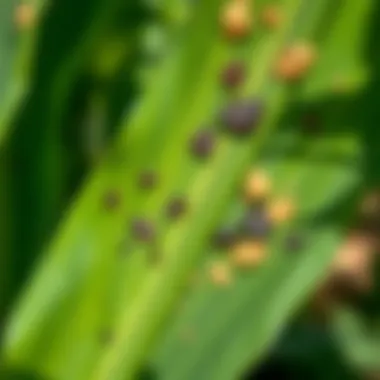
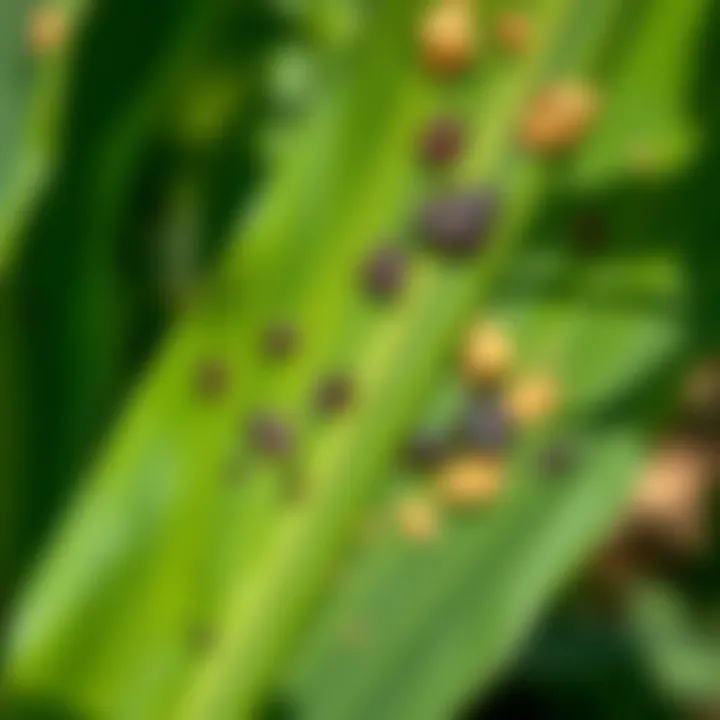
Powdery Mildew
Powdery mildew is a fungal disease caused by various species of the genus Erysiphe. This disease tends to thrive in warm and humid conditions, which makes it especially troublesome during certain seasons. One key characteristic of powdery mildew is its distinctive white, powdery appearance on leaves, which could easily be mistaken for harmless dust. Its ramifications can be severe, as the disease can lead to reduced photosynthesis, stunted growth, and even premature leaf drop.
It stands out as a significant choice in this discourse because its rapid spread can catch farmers off guard. The unique feature of powdery mildew is its ability to spread through air currents and can infect entire fields in a very short time. While it's beneficial to emphasize awareness of this disease, the downside is its capacity to quickly adapt and become resistant to certain fungicides.
Brown Spot
Brown spot is another brutal foe for soybean crops, mainly caused by Septoria glycines. This disease manifests as small, dark brown lesions on the leaves, which ultimately lead to a yellowing of the plant. One critical aspect of brown spot is that it can thrive in various soil conditions, making it prevalent in many farming areas.
The notable characteristic that sets it apart is how it develops in conjunction with high humidity and moderate temperatures, making farmers vigilant during particular weather patterns. Brown spot may also result in decreased yields, impacting not just immediate profits, but long-term soil health as earlier stress can weaken plants. Understanding its life cycle helps farmers identify the best times and products for management, setting a proactive rather than reactive tone.
Phytophthora Root Rot
Phytophthora root rot, caused by the pathogen Phytophthora sojae, is particularly destructive, often root-deep in its impact. This disease appears more prominently in poorly drained soils, creating an urgent awareness among farmers about their soil management practices. The classic symptom is the darkening of the roots, but its real contribution to overall crop health involves prevention of nutrient uptake, crippling healthy growth.
What makes Phytophthora root rot a staunch adversary is its ability to survive in the soil even under adverse conditions, meaning that once introduced, it can become a recurring issue for many seasons. In some cases, plants may wilt suddenly, causing a headache for farmers who, unaware of the rot, may overlook preventive fungicides. This disease's complexities emphasize the need for integrated management practices involving crop rotation and targeted fungicidal approaches.
Symptoms and Diagnosis of Soybean Diseases
Recognizing the symptoms of soybean diseases is vital for effective management. Farmers need to differentiate between various signs that arise from different pathogens to employ the right strategies. Common symptoms include discolored leaves, wilting, stunted growth, and abnormal lesions. Early diagnosis can mean a world of difference between recovery and hefty losses, emphasizing that awareness is as crucial as the solutions themselves.
"Monitoring fields regularly is the best way to catch issues before they escalate. Knowledge is power in the world of agriculture." - Crop Expert
By understanding these common diseases and their implications, farmers can better equip themselves with strategies tailored to safeguard their crops.
Prolusion to Fungicides
Fungicides hold a significant place in the agricultural toolkit, especially for soybean cultivation. Their role goes beyond mere disease control; they are integral to ensuring a healthy crop yield. With the increasing challenges posed by fungal diseases, farmers need to adopt effective fungicide strategies. It's not just about applying chemicals; understanding how these substances work can make all the difference in achieving optimal results.
When we talk about soybeans, we're discussing a crop that is not only economically vital but also crucial for food security. The use of fungicides helps mitigate risks tied to various diseases that could lead to devastating losses. Therefore, grasping the nature and classification of fungicides equips soybean farmers with the necessary knowledge to safeguard their crops against unforeseen threats.
What Are Fungicides?
Fungicides are specialized agricultural chemicals designed to combat fungal infections in plants. Unlike herbicides that target weeds, fungicides focus specifically on fungi. These pathogens can wreak havoc on crops, leading to reduced yields and compromised quality. Thus, fungicides become essential allies in the farmer's quest for healthy soybean harvests.
Fungicides can be applied preemptively or in response to existing infections. Their efficiency depends on factors like timing, application method, and even the specific diseases being targeted. It's crucial for farmers to not just spray fungicides but to understand the underlying mechanisms that make these products effective.
Types of Fungicides
Understanding the different categories of fungicides is paramount for effective disease management. Each type has its distinct properties and uses, allowing farmers to tailor their approach to specific situations.
Systemic Fungicides
Systemic fungicides are absorbed by plants, moving through their tissues to provide protection against localized and systemic infections. They work internally, targeting fungi that have invaded the plant's system. This is a key characteristic because it allows for longer-lasting protection compared to other types.
One unique feature of systemic fungicides is their ability to act even after application. If conditions turn favorable for fungal growth post-application, these fungicides can still offer a line of defense. However, their reliance on plant uptake means that timing and soil conditions must be optimal for effectiveness, making their application strategy quite critical.
Contact Fungicides
On the other hand, contact fungicides create a protective barrier on the surface of plant leaves. They function by preventing spores from germinating or penetrating leaf tissues. This key characteristic makes them a go-to choice for managing surface infections. Unlike systemic options, contact fungicides don’t enter the plant’s system but are excellent for immediate defense against infections that have not yet established.
A particular strength of contact fungicides is their rapid action upon application. However, they require thorough coverage and must be reapplied after rain or irrigation, making them less convenient in prolonged wet conditions.
Biological Control Agents
Biological control agents are increasingly gaining traction as a sustainable alternative to chemical fungicides. They consist of living organisms or natural products that suppress fungal diseases through various mechanisms. Their key characteristic lies in promoting an ecological balance within the farming environment by enhancing biodiversity. These agents often repel or outcompete harmful fungi.
One unique feature of biological control is that they typically have fewer harmful side effects on beneficial microorganisms and the broader ecosystem. However, they may require specific conditions or practices to be effective, potentially making them less straightforward than traditional fungicides.
In summary, understanding the types of fungicides available can empower soybean farmers to apply the most effective measures against fungal diseases. By selecting the right type based on crop conditions and disease presence, farmers can significantly improve their yields.
Active Ingredients in Soybean Fungicides
The selection of the right fungicide often hinges on the active ingredients it contains. These ingredients play a pivotal role in controlling diseases while ensuring the safety of the crop. Understanding what active ingredients are most effective in combating soybean diseases allows farmers to make better-informed decisions. Given soybeans’ rise in prominence as a cash crop, knowing how to maximize yield through the right fungicides becomes paramount.
Key Active Ingredients
Azoxystrobin
Azoxystrobin stands out due to its broad-spectrum activity against a variety of fungi. It’s a systemic fungicide, meaning it’s absorbed by the plant and can protect tissues that have yet to be attacked. One key characteristic of Azoxystrobin is its ability to prevent spore germination and fungal growth by inhibiting mitochondrial respiration. This makes it a popular choice among farmers.
Its unique feature lies in its long-lasting effects, offering protection that often lasts longer than other fungicides. However, while it effectively curtails fungal diseases, there's concern about potential resistance development. This necessitates careful management when rotating with other fungicides.
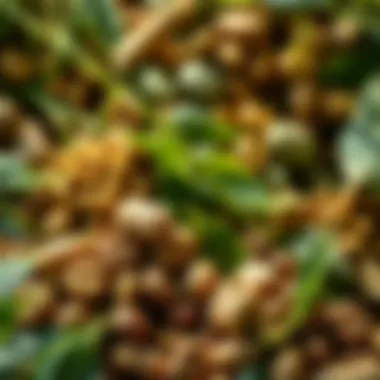
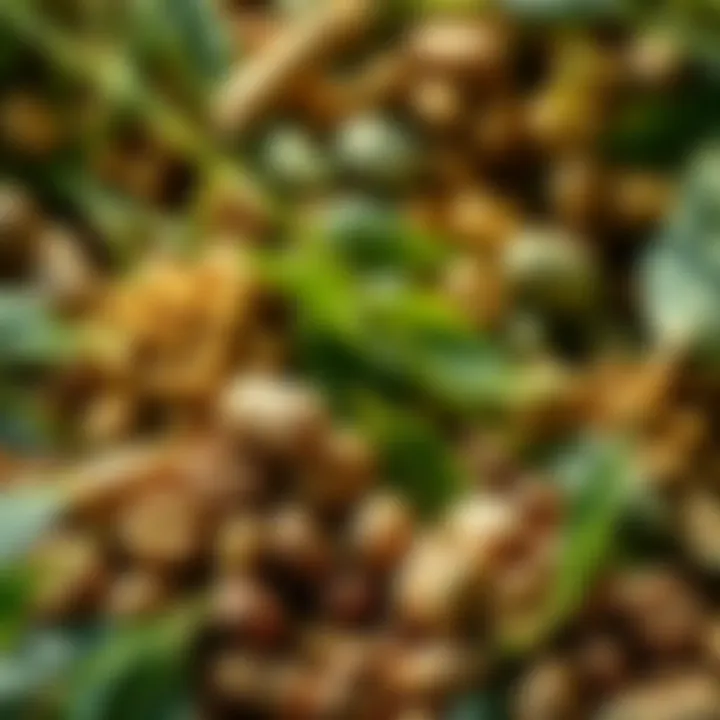
Benzovindiflupyr
Benzovindiflupyr operates through a completely different mechanism; it disrupts cellular processes within the fungus, effectively killing it before it can take hold of the soybean plant. This active ingredient quickly gained traction due to its effectiveness against several stubborn fungal pathogens. A major draw is its favorable profile regarding crop safety and environmental impact.
Unique to Benzovindiflupyr is its ability to mitigate the risk of resistance thanks to its mode of action. However, it’s worth noting that the window for application requires precision; too early or too late can diminish its effectiveness.
Iprodione
Known for its efficacy in preventing diseases like brown spot fungus, Iprodione is a contact fungicide. This means its action is surface-level and doesn’t penetrate the plant tissues. The major benefit of Iprodione is its quick action; it can inhibit fungal growth almost immediately upon application.
However, its limitation comes with the need for thorough coverage of the plant surface, which can be challenging under certain field conditions. Also, farmers have reported mixed results concerning its residual effectiveness depending on weather conditions, specifically rainfall.
Carbendazim
Carbendazim is a well-known fungicide that controls a wide array of fungal diseases. It works by inhibiting mitotic spindle formation in fungal cells, effectively stopping cell division and growth. Its key characteristic is that it is both effective as a curative and preventative treatment, making it versatile in its application.
Despite its advantages, Carbendazim has faced scrutiny regarding its environmental impact. The downsides of misuse include potential effects on non-target organisms, prompting the need for careful stewardship when using it in the field.
Mechanisms of Action
Understanding how these active ingredients work is crucial for ensuring effective disease control. Each ingredient targets fungal cells differently, either by disrupting cellular respiration, preventing cell division, or inhibiting growth at various stages. This selection is not just about effectiveness; it encompasses safety, cost, and environmental impacts, which are all critical in today’s sustainable farming practices.
"The right active ingredient can mean the difference between a bountiful harvest and a struggling crop."
Evaluating the Best Fungicides for Soybeans
When it comes to soybeans, understanding the best fungicides available is paramount. This section delves into essential considerations that guide farmers in selecting appropriate products. Evaluating these fungicides ensures not just healthy plants but also maximizes crop yield efficiently. The proper evaluation rests on several key factors including efficacy, safety, and cost-effectiveness. Each of these elements plays a crucial role in determining the best approach for disease management in soybean agriculture.
Criteria for Selection
Efficacy
Efficacy is all about how well a fungicide performs against specific diseases. Effective fungicides can significantly reduce disease incidence and improve plant health, leading to healthier crops and higher yields. The standout feature of efficacy is its measurable impact on crop outcome. Products with high efficacy are a go-to choice for many farmers because they can offer substantial returns on investment. However, one must also consider the unique features of each effective product. For instance, some fungicides may provide quicker results but could require more frequent applications, while others may last longer but offer less immediate impact. This push and pull highlights the need for thoughtful consideration in selecting the right fungicide.
Safety
Safety is another cornerstone when evaluating fungicides. It's essential that products not only protect the soybean plants but also consider the health risks to farmers and the surrounding environment. A key characteristic here is the balance between potency against fungi and safety for humans, animals, and beneficial insects. Fungicides that pass this safety test are often preferred for usage in agricultural settings. One unique feature of these safe options often involves reduced toxicity levels, allowing a broader range of application methods without substantial risk. However, sometimes a safer product might mean a trade-off in potency, requiring a more strategic application plan to ensure desired outcomes.
Cost-Effectiveness
Cost-effectiveness ties directly into the economic viability of fungicide use. Understanding this aspect helps farmers maximize profits while minimizing costs. The key characteristic of this criterion is the relationship between the price of the fungicide and the yield improvement it facilitates. Products that show a clear path of high returns on investment become standouts in their category. However, calculating cost-effectiveness shouldn’t merely focus on upfront costs; it's crucial to consider factors like the duration of action and required application intervals. A less expensive option upfront might actually lead to higher costs in the long run if it demands more frequent applications.
Top Rated Fungicides for Soybean Cultivation
Product A: Features and Benefits
Beginning with a well-known tool in the arsenal, Product A stands out for its high efficacy against multiple common soybean diseases. The key feature here is its systemic action, allowing it to be absorbed by the plant and work from within. This means it not only tackles existing infections but provides a proactive defense against future threats. Many farmers appreciate this product for its consistent performance across various seasons, proving beneficial in diverse climates. Nonetheless, users should keep in mind its specific dosage requirements, which can be complex during application.
Product B: Features and Benefits
Next up is Product B. Known for its robust formulation, this fungicide delivers excellent safety credentials while still maintaining efficacy. Its standout characteristic is its reduced toxicity to both humans and beneficial insects, making it popular amongst organic farmers. It also offers lasting protection that ensures a longer window of disease resistance. However, some users note that it might be slightly less effective against severe infestations compared to stronger alternatives, which could necessitate a companion product for complete assurance.
Product C: Features and Benefits
Last, we consider Product C, which has gained traction for its cost-effectiveness. Offering a broad-spectrum capability, it covers a wide range of diseases. The essence of its appeal lies in its affordability while still providing reasonable levels of efficacy. Many farmers flock to it for being budget-friendly, particularly during tight economic seasons. However, while the price point is attractive, some may find that it requires more frequent applications, possibly impacting labor and management time in the field.
It's crucial to weigh these factors carefully when selecting an appropriate fungicide to ensure that it aligns with both your crop health goals and economic conditions.
Application Best Practices
When it comes to soybean cultivation, the application of fungicides is not just an afterthought; it's an essential component of safeguarding crop health and maximizing yields. Best practices in application not only enhance the effectiveness of the fungicides but also help in mitigating risks associated with overuse or misuse. Understanding these practices can lead to better management decisions, ensuring both economic viability and environmental sustainability. Here are a few specific elements to consider:
- Efficacy: Proper application can significantly increase the effectiveness of fungicides. Timing and methods can either amplify or undermine the intended results.
- Safety: Safe application protects not just the plants but also the applicator and the surrounding ecosystem. Proper techniques reduce the risk of drift and exposure to non-target organisms.
- Cost-Effectiveness: When fungicides are applied correctly, it reduces the need for repeat applications, which can save farmers money in the long run.
Timing of Application
Timing is everything in agricultural management, and when it comes to fungicides for soybeans, application timing can make the difference between success and failure. Fungicides must be applied at the right moment to be effective. Generally, the optimal timing is influenced by the growth stage of the soybean plants and the specific disease threats they face. For instance, applying before signs of disease appears can prevent issues from escalating, whereas late applications may only help in curtailing existing problems.
Also, external factors such as weather, soil moisture, and regional pest pressure should not be overlooked. This proactive approach enables farmers to combat diseases effectively while ensuring their investment is protected.
Application Methods
Spraying Techniques
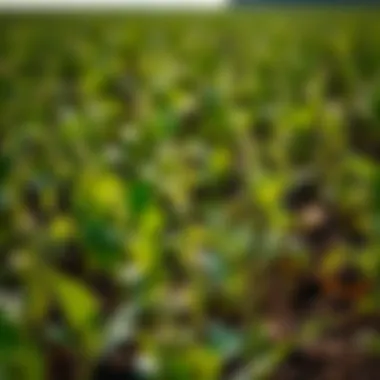
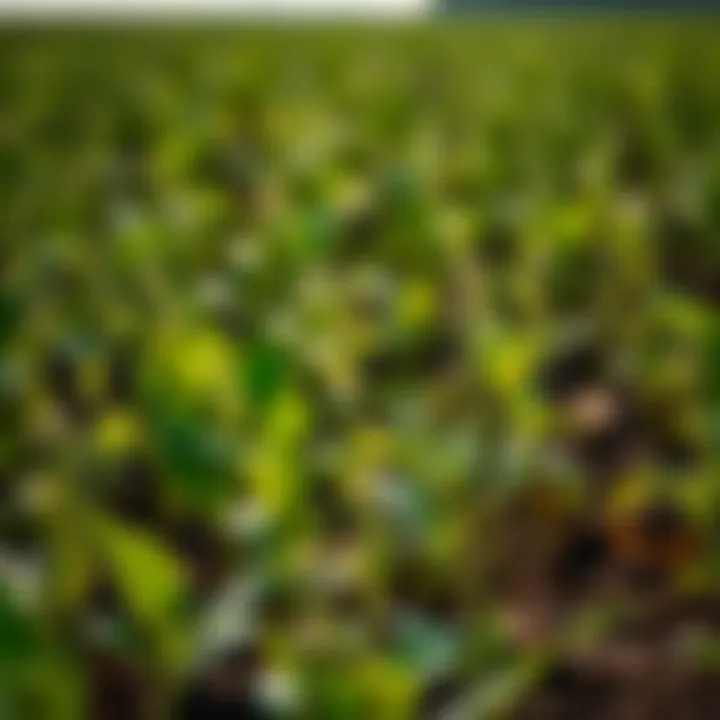
Spraying is one of the most common methods used for applying fungicides, and for good reason. This technique ensures even distribution across the plant’s surface, maximizing contact with any fungal pathogens. The key characterisitic of spraying is its adaptability; it can be easily altered to suit different crop conditions.
One notable advantage of spraying is its quick application time, which allows farmers to treat large fields without significant downtime. However, attention must be paid to factors such as droplet size, pressure, and wind conditions to avoid drift onto non-target areas. While it is a popular choice, farmers need to take into consideration the potential for runoff, especially in heavy rain.
Fertigation
Fertigation, the process of applying fertilizers and pesticides through irrigation systems, is a growing method in modern agriculture, particularly for soybean crops. Its unique feature lies in its efficiency; it allows for precise application of fungicides directly to the root zone. This method not only promotes the optimal uptake of active ingredients but also minimizes waste and potential leaching into the environment.
Another key characteristic of fertigation is that it saves time and labor—once set up, it can be automated to run with irrigation schedules. However, it does require a well-designed irrigation system and thorough monitoring to ensure correct doses are delivered. Farmers also need to be cautious of potential clogging in irrigation equipment when using certain fungicides.
In summary, whether through spraying or fertigation, understanding the best practices in timing and application methods plays a crucial role in managing soybean health effectively. Each method comes with its advantages and some disadvantages that require careful consideration depending on the specific farming context. Incorporating these techniques can lead to more productive and sustainable soybean farming.
Resistance Management Strategies
Managing resistance to fungicides is more important than ever in soybean cultivation. As farmers strive to maximize their yields and maintain crop health, the threat posed by resistant fungal strains looms large. When fungicides are continuously used, some pathogens can evolve mechanisms to withstand their effects, leading to treatments that no longer work as expected. This phenomenon underscores the necessity of incorporating resistance management strategies into routine farming practices. By doing so, farmers can enhance their ability to control diseases, thereby sustaining their harvest and profit margins.
Understanding Fungicide Resistance
Fungicide resistance occurs when fungi develop genetic changes that make them less susceptible to specific chemical treatments. This could result from various factors including, but not limited to, the overuse of a single fungicide or applying them without adherence to recommended guidelines.
The mechanisms behind this are fascinating. For example, some fungi can alter the target sites where the fungicides are meant to act, rendering the chemicals ineffective. Others may enhance their ability to pump out the chemicals before they can cause harm. As a consequence, farmers may find themselves facing an uphill battle against diseases that were once manageable.
Key points to understand about fungicide resistance include:
- Genetic Variation: Pathogens naturally contain genetic diversity, which may lead to some individuals developing resistance to fungicides.
- Selective Pressure: Repeated use of a fungicide can place pressure on the fungal population, leading to a higher proportion of resistant strains.
- Economic Impact: Crop losses due to resistant strains can add up, making it vital for farmers to adapt their practices.
"Fungicide resistance is not a sudden phenomenon; it is the result of years of evolving strains and farming practices."
Employing Resistance Management Techniques
Effective resistance management techniques are crucial for prolonging the efficacy of fungicides. A multifaceted approach is recommended, incorporating various strategies that complement each other. Here are some practical techniques that can be applied:
- Rotate Fungicides: Use fungicides with different modes of action in your spray program. This minimizes the chances of pathogens adapting to any single active ingredient.
- Integrated Pest Management (IPM): Combine fungicide applications with other control measures, such as crop rotation, resistant cultivars, and cultural practices. This well-rounded approach can diminish dependence on chemical treatments.
- Monitor and Decision-Making: Regularly scout your fields for disease presence and severity. Make informed decisions about fungicide applications based on actual disease levels rather than set schedules.
- Educate and Update: Stay informed about the latest research and trends related to fungicide resistance. Join forums like those found on Reddit to exchange ideas and experiences with fellow soybean farmers.
- Apply at the Right Time: Timing can be everything. Applying fungicides at the onset of the disease rather than in advance can reduce the risk of unnecessary applications and help to manage resistance more effectively.
By implementing these techniques thoughtfully, farmers not only manage resistance but also set a foundation for sustainable agriculture. In a time when agricultural practices are scrutinized for their impact on the environment, these strategies help to ensure a balanced approach that conserves valuable resources.
Environmental Considerations
In the quest for enhancing soybean productivity, the environmental impact of fungicides cannot be overlooked. Understanding how these chemicals interact with the ecosystem is paramount for sustainable agriculture. This discussion emphasizes that while fungicides are effective in managing plant diseases, their usage must be balanced with environmental safeguarding practices. Their influence on soil organisms, water quality, and non-target species bring forth critical considerations for farmers. Educating oneself about these factors fosters responsible fungicide application and ensures a healthier ecosystem.
Impact of Fungicides on Ecosystem
Fungicides can have a plethora of effects on ecosystems, especially when used indiscriminately. From beneficial insects to microbial communities in the soil, the ramifications can be significant.
- Soil Health: Regular application of certain fungicides can diminish beneficial microorganisms, crucial for soil fertility. When such organisms decrease, soil structure and nutrient cycling can be adversely affected, leading to long-term degradation.
- Aquatic Systems: Runoff from treated fields can contaminate nearby water bodies. Pesticide residues in rivers and lakes can disrupt aquatic life, leading to a decline in fish populations and harming entire food webs.
- Biodiversity: The broader impact extends to biodiversity. Non-target organisms such as bees and butterflies may suffer from exposure to fungicides, further threatening pollination processes vital for crop production and wild flora.
Monitoring and assessing these impacts is essential. For example, recent studies indicate that certain systemic fungicides can persist in the environment longer than anticipated, raising alarms about their potential to accumulate in food chains. This continual monitoring poses a challenge but is necessary to ensure the longevity of farming practices while also protecting the environment.
"Sustainable farming is not just about feeding the world today, but ensuring that the earth can feed future generations."
Sustainable Practices in Fungicide Use
Adopting sustainable practices when using fungicides is critical in mitigating environmental effects. Here are several approaches that can enhance environmentally friendly fungicide application:
- Integrated Pest Management (IPM): Combine biological control methods with chemical applications to minimize reliance on fungicides. Utilizing resistant soybean varieties can also reduce disease incidence.
- Targeted Application: Instead of blanket spraying, use precision technologies to apply fungicides only where needed. This could involve using satellite imagery or soil moisture sensors to determine when and where to apply.
- Read and Follow Label Directions: Farmers need to strictly adhere to the usage guidelines provided. This ensures not just efficacy but also environmental safety.
- Timing of Application: Apply fungicides at times when environmental conditions favor fewer adverse effects. For instance, avoiding applications before heavy rainfall can reduce runoff.
By implementing these methods, farmers can align their practices with ecological well-being while reaping the benefits of using fungicides in soybean production. Sustainability in fungicide use isn't just an obligation but a pathway to keep the agricultural dialogue richer and healthier for generations to come.
For additional insight, guidelines, and updates on sustainable farming practices, resources such as USDA.gov and EPA.gov provide comprehensive information that every soybean farmer should consider.
Epilogue and Future Directions
As we wrap up this extensive examination of fungicides and their pivotal role in soybean cultivation, it becomes clear that the topic extends far beyond mere application. Understanding how to effectively utilize fungicides is vital for maximizing yield and ensuring a sustainable practice in agriculture. The findings presented throughout this article highlight not only the importance of selection but also the need for farmers to adapt their strategies continuously against evolving challenges in soybean diseases.
The dynamics of agriculture are always shifting, influenced by environmental factors, market trends, and advances in scientific research. As we look to the future, the ability of soybean farmers to adopt and implement innovative fungicides will be crucial to maintaining high productivity levels and combating resistant strains of pathogens. Here are some key points to take away:
- The importance of sound management practices cannot be overstated. A proactive approach, combined with information on the latest developments, will equip farmers to tackle uncertainties in crop health.
- Emphasizing integrated pest management (IPM) practices along with fungicides can lead to long-term success by reducing reliance on chemical treatments.
- Investing in research and development of new fungicides tailored for specific soybean diseases may change the landscape of soybean farming, providing potent solutions where they are needed most.
Summary of Key Insights
In reviewing the core aspects of fungicide application, a few insights stand out:
- Diversity of Options: There's a wide array of fungicides available, each with unique attributes suited to different disease threats. Understanding these options allows farmers to customize their disease management plans effectively.
- Active Ingredients Matter: Knowing the active ingredients, like Azoxystrobin or Carbendazim, and their mechanisms can guide effective product selection.
- Importance of Timing: The impact of timing and method of application significantly influences efficacy. Spraying during critical windows of a crop's development is essential for maximizing disease control.
- Environmental Considerations: Sustainable practices in the use of fungicides are paramount. Awareness of their impact on the ecosystem can inform better decision-making.
Emerging Trends in Soybean Fungicide Research
The field of soybean fungicide research is dynamic, with numerous trends emerging that warrant attention:
- Biological Control Agents: There’s a growing interest in the potential of biological formulations, leveraging natural predators or competitors to mitigate fungal diseases.
- Nanotechnology: Advances in nanotechnology are paving the way for enhanced fungicide delivery systems. These methods promise greater efficacy and lower environmental impact by increasing absorption while minimizing usage rates.
- Data-Driven Approaches: Precision agriculture is starting to meld with fungicide application techniques. By utilizing data analytics and field mapping technologies, farmers can now deploy fungicides more judiciously based on real-time data assessments.
- Resistant Strain Research: As pathogens develop resistance, research focused on alternative compounds and strategies to counteract these pathogens is increasingly critical.
In summary, understanding the trends in soybean fungicide research provides farmers with a means to stay ahead of the curve. Embracing innovation is not just an option but a necessity as agriculture faces new environmental and economic challenges.



